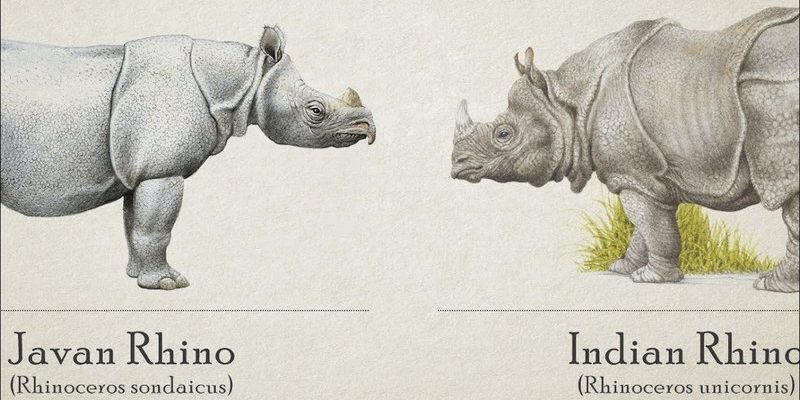![Comparing The Javan Rhinoceros Vs. [Similar Species]](https://gudri.com/wp-content/uploads/2025/06/Comparing_The_Javan_Rhinoceros_Vs___Similar_Species__image_0.jpg)
Physical Characteristics
Both the Javan and Indian rhinos are impressive creatures, but they wear their differences like colorful jackets. The Javan rhino is smaller than its Indian counterpart, usually weighing between 1,800 and 2,200 pounds. With a single horn, it can look sleek and agile, ready to navigate through dense forests.
In contrast, the Indian rhinoceros boasts a more robust figure, tipping the scales at 4,000 to 5,000 pounds. Its most striking feature is the prominent bump on its back, making it look almost armored. Plus, it has two horns, which give it a more fearsome appearance. You might even imagine the Indian rhino as a medieval knight, clad in armor and always ready for battle!
Another key difference lies in their skin texture. The Javan rhino’s skin appears more folded, while the Indian rhino has a thick, wrinkled look. Both adaptations help these animals survive in their respective habitats, from dense jungles to open grasslands.
Habitat and Distribution
Let’s take a virtual journey to see where these magnificent creatures call home. The Javan rhino is primarily found in Ujung Kulon National Park in Indonesia. This area is rich in tropical forests, which provide shelter and food for this elusive species. Interestingly, the Javan rhino is a great swimmer, so you might catch one wading through rivers or lakes.
On the flip side, the Indian rhinoceros is more widespread, with populations found in India and Nepal, particularly in grasslands and river valleys. You could say that the Indian rhino embraces a more varied lifestyle, thriving in different environments, from tall grass to wetlands. It’s like the social butterfly of the rhino family, adapting to different landscapes without missing a beat.
Sadly, both species face serious threats from habitat loss and poaching. Conservation efforts are crucial to ensure they don’t fade away. Just picture the lush jungles of Indonesia and the grassy plains of India devoid of these magnificent animals; it’s a thought we must avoid at all costs.
Behavior and Diet
When it comes to behavior, both the Javan and Indian rhinos have unique traits shaped by their environments. The Javan rhino is generally more solitary, often found roaming alone or with just a mother and calf. This shy behavior makes them challenging to study, like a reserved artist who prefers to work in silence.
In contrast, Indian rhinos are often spotted in small groups, particularly females with their young. They’re social creatures that enjoy the company of others, and you might see them basking in the sun together or munching on grass.
Speaking of munching, their diets also differ slightly. The Javan rhino is a browser, meaning it prefers to nibble on leaves, shrubs, and fruits, primarily found in forests. The Indian rhino, on the other hand, is a grazer, feasting on grasses, fruits, and some leaves. If you ever see one chomping away, it’s like watching a lawnmower in action!
Reproductive Patterns
Reproduction is a vital part of any species’ survival. The Javan rhino has a longer gestation period of around 16 to 18 months, producing a single calf at a time. Caring for the young is a full-time job, and mothers are quite protective, ensuring their little ones stay close.
The Indian rhino also has a similar gestation period, but it can sometimes bear twins, which is quite rare and exciting! It’s like winning the lottery in the wildlife world. Both species are known for their nurturing nature, but the Indian rhino’s adaptability allows it to handle a slightly more variable reproductive success.
Interestingly, both species reach sexual maturity at different ages. Javan rhinos typically mature later than Indian rhinos, which can lead to challenges in their survival, especially when populations are low. In a world where every new calf counts, these differences matter.
Conservation Status and Threats
Conservation is a pressing concern for both the Javan and Indian rhinos. The Javan rhino, classified as critically endangered, is on the brink of extinction, mostly due to poaching and habitat loss. The Indonesian government and various organizations are working tirelessly to protect their habitats and monitor the remaining population.
On the other hand, the Indian rhinoceros has made a comeback thanks to concerted conservation efforts, but they are still vulnerable. Their population is increasing, albeit slowly. Strict anti-poaching laws and habitat conservation have contributed to their survival, yet threats still loom large, especially as human activity expands into their natural habitats.
It’s a heartbreaking reality that connects both species, illustrating the delicate balance of life on Earth. We must recognize the importance of these animals and the roles they play in their ecosystems. Without them, we might lose not just their presence but a part of our natural heritage.
In comparing the Javan rhinoceros and the Indian rhinoceros, we see the incredible diversity within the rhino family. Each species has its own unique characteristics, habitats, and challenges. While the Javan rhino is a ghostly figure on the brink of extinction, the Indian rhino shows us that with proper care and conservation, hope is possible.
Honestly, protecting these magnificent creatures isn’t just about saving them; it’s about preserving a piece of our planet’s identity. As we sip our coffee and chat, let’s remember the importance of wildlife conservation and how we can all play a part in it. Every action counts, whether it’s spreading awareness or supporting conservation efforts. Together, we can ensure that future generations will marvel at the sight of both the Javan and Indian rhinos roaming their lands.

